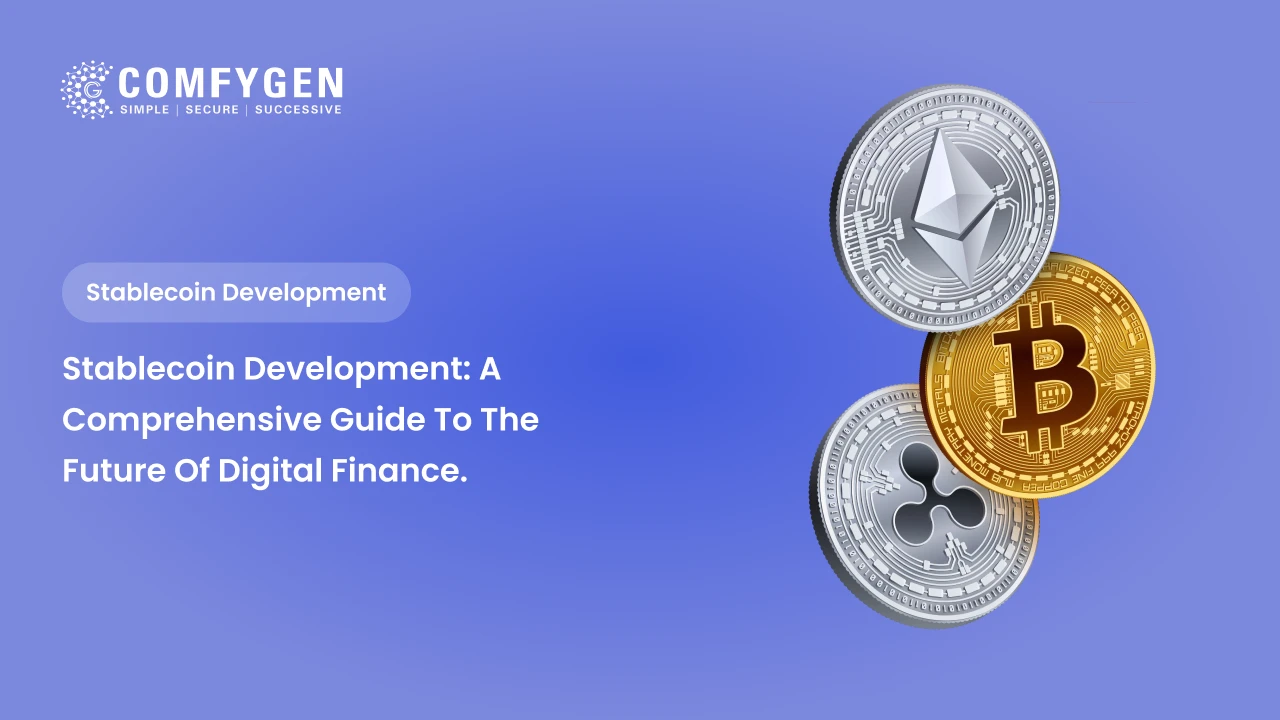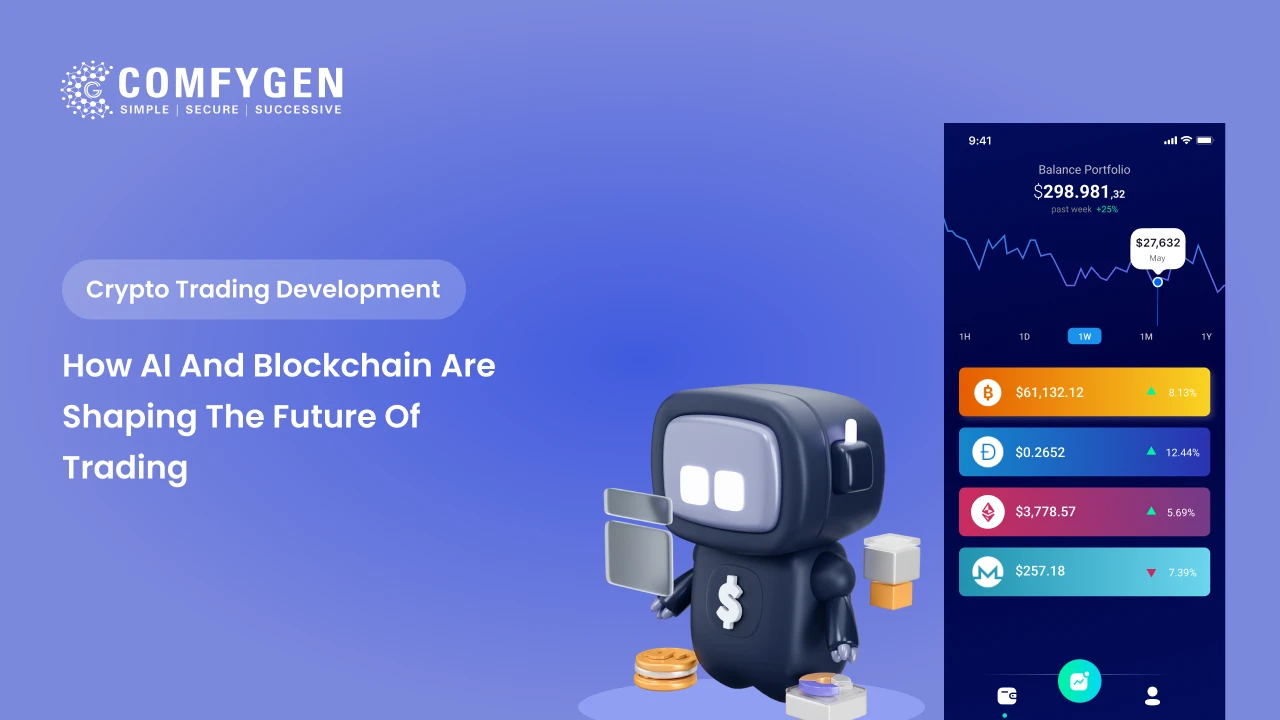Stablecoin Development: A Comprehensive Guide to the Future of Digital Finance
Introduction: Understanding Stablecoins and Their Growing Importance
As the world of cryptocurrencies continues to evolve, stablecoins have emerged as a crucial player in the financial ecosystem. Bridging the gap between traditional finance and the decentralized world of digital assets, stablecoins are gaining popularity for their ability to maintain a stable value amidst the volatile nature of other cryptocurrencies.
This blog will delve into what stablecoins are, how they work, the process of stablecoin development, and why they are crucial for the future of digital finance.
What are Stablecoins?
Stablecoins are a category of cryptocurrencies designed to minimize the price volatility that is typically seen in the crypto market. Unlike traditional cryptocurrencies like Bitcoin and Ethereum, which experience significant fluctuations in value, stablecoins are pegged to a specific asset, such as a fiat currency (like the US Dollar or Euro) or a commodity (like gold). This pegging mechanism ensures that the value of a stablecoin remains stable relative to its underlying asset.
The key feature of stablecoins is their ability to provide the benefits of cryptocurrency, such as fast transactions, lower fees, and decentralization, while avoiding the extreme volatility that can make other cryptocurrencies impractical for everyday transactions. As such, stablecoins are gaining traction as a reliable medium of exchange, store of value, and unit of account in the world of digital finance.
Types of Stablecoins
There are several types of stablecoins in circulation, each with its mechanism for maintaining a stable value. These can be broadly classified into three categories:
1. Fiat-Collateralized Stablecoins
Fiat-collateralized stablecoins are the most common type of stablecoins. These stablecoins are backed 1:1 by a fiat currency, such as the US Dollar, Euro, or British Pound. The value of the stablecoin is directly linked to the value of the fiat currency it is pegged to.
Examples of fiat-collateralized stablecoins include:
Tether (USDT): One of the largest and most widely used stablecoins, USDT is pegged to the US Dollar and is available on various blockchains like Ethereum, Tron, and Solana.
USD Coin (USDC): Another prominent stablecoin, USDC is also pegged to the US Dollar and is primarily used for stable and secure transactions on the Ethereum blockchain.
2. Crypto-Collateralized Stablecoins
Crypto-collateralized stablecoins are backed by other cryptocurrencies, rather than fiat currencies. These stablecoins are often over-collateralized to account for the price volatility of the backing assets. In cases where the value of the collateral falls below a certain threshold, the system automatically liquidates the collateral to maintain the stability of the stablecoin.
Example of a crypto-collateralized stablecoin:
DAI: DAI is a decentralized stablecoin that is pegged to the US Dollar. It is collateralized by other cryptocurrencies such as Ethereum and uses smart contracts to maintain its stability.
3. Algorithmic Stablecoins
Algorithmic stablecoins do not rely on collateral but instead use algorithms and smart contracts to regulate the supply of the stablecoin. When the price of the stablecoin deviates from its target value, the system adjusts the supply, either minting more coins or burning excess coins, to restore the value to its peg.
Example of an algorithmic stablecoin:
Ampleforth (AMPL): Unlike fiat-collateralized stablecoins, AMPL adjusts its supply in response to market demand. This makes it more flexible but also introduces new challenges in ensuring price stability.
The Role of Stablecoins in Cryptocurrency Development
Stablecoins have revolutionized the cryptocurrency ecosystem in several ways. While traditional cryptocurrencies like Bitcoin and Ethereum offer investment opportunities, stablecoins address key pain points that have historically hindered the mass adoption of digital currencies. Here are some key areas where stablecoins play a crucial role:
1. Enabling Seamless Payments
Due to their stable value, stablecoins are an ideal medium of exchange for payments, especially for cross-border transactions. Traditional banking systems often involve high fees and long processing times, particularly for international payments. Stablecoins, on the other hand, provide a more efficient and cost-effective solution for transferring value globally, without the volatility risk of other cryptocurrencies.
2. Stable Store of Value
For businesses and individuals who want to protect the value of their digital assets, stablecoins offer a secure option. Their peg to stable assets like the US Dollar ensures that their value remains relatively unaffected by the fluctuations of the broader crypto market. This stability makes stablecoins a safer alternative for storing value compared to more volatile cryptocurrencies.
3. Decentralized Finance (DeFi)
Stablecoins have become a cornerstone of decentralized finance (DeFi) platforms, where they are used as collateral for lending, borrowing, and staking. The ability to access financial services without relying on traditional intermediaries like banks is a major attraction of DeFi platforms, and stablecoins provide a way for users to engage in these activities without the risk of price swings.
4. Reducing Transaction Costs
Because stablecoins are digital and often operate on blockchain networks, they can significantly reduce transaction costs compared to traditional banking methods. Additionally, they enable instant transactions, allowing users to send and receive payments in real-time without the delays associated with bank transfers or international payments.
The Stablecoin Development Process
Developing a stablecoin involves several crucial steps that require careful planning, regulatory compliance, and technical expertise. Below are the key stages in the stablecoin development process:
1. Define the Type of Stablecoin
The first step in developing a stablecoin is determining the type of stablecoin to create—fiat-collateralized, crypto-collateralized, or algorithmic. This decision will depend on the use case, target market, and the level of decentralization desired. Each type of stablecoin comes with its own set of benefits and challenges, so careful consideration is required.
2. Choose the Underlying Asset
For fiat-collateralized stablecoins, the next step is selecting the underlying fiat currency (e.g., the US Dollar, Euro, etc.) or commodity (e.g., gold). The reserve asset must be held in a trusted institution or in a decentralized manner to ensure transparency and security.
For crypto-collateralized stablecoins, developers need to select the cryptocurrencies that will serve as collateral. In these cases, the collateral must be managed through smart contracts that adjust based on market conditions.
3. Develop the Smart Contracts
Stablecoins typically rely on smart contracts to maintain their stability and manage the issuance and redemption of tokens. These smart contracts ensure that the value of the stablecoin is pegged to the underlying asset and that any fluctuations in value are corrected through supply adjustments (in the case of algorithmic stablecoins) or collateral liquidation (in the case of crypto-collateralized stablecoins).
4. Audit and Regulatory Compliance
One of the most critical steps in stablecoin development is ensuring that the project complies with relevant regulations. Depending on the jurisdiction, stablecoin developers may need to work with regulatory bodies to ensure that their stablecoin meets the necessary legal and financial standards. Regular audits are also essential to maintain transparency and build trust with users.
5. Launch and Market the Stablecoin
After development and testing, the stablecoin can be launched on a blockchain network, such as Ethereum, Binance Smart Chain, or Solana. Developers will need to market their stablecoin to attract users and integrate it into existing cryptocurrency exchanges, wallets, and DeFi platforms.
6. Ongoing Maintenance and Monitoring
Once the stablecoin is live, ongoing maintenance and monitoring are essential to ensure its continued stability and security. This includes monitoring the reserve assets, adjusting the supply as needed, and addressing any vulnerabilities in the smart contracts or blockchain network.
Why Choose Stablecoin Development Services?
With the increasing demand for stablecoins, businesses and developers alike are turning to stablecoin development services to create their stablecoins or integrate them into existing platforms. Here are some key reasons to consider stablecoin development services:
1. Expertise and Experience
Developing a stablecoin requires a high level of technical expertise in blockchain technology, smart contracts, and regulatory compliance. Professional stablecoin development services offer the skills and experience needed to create a secure, reliable, and compliant stablecoin.
2. Customization
Stablecoin development services allow businesses to customize their stablecoin to meet specific needs and use cases. Whether it’s integrating with a DeFi platform, supporting cross-border payments, or creating a loyalty program, development services can tailor the stablecoin to fit your unique requirements.
3. Regulatory Compliance
As governments and regulatory bodies around the world work to establish clear guidelines for cryptocurrency, ensuring that your stablecoin complies with relevant laws is essential. Professional development services stay up-to-date with the latest regulations and ensure that your stablecoin meets all legal requirements.
4. Security and Audits
Security is a top priority in stablecoin development, and working with experienced developers ensures that the stablecoin is built with the highest security standards. Regular audits and vulnerability assessments are critical to maintaining the integrity of the stablecoin and protecting it from cyber threats.
Conclusion: The Future of Stablecoin Development
Stablecoins are poised to play a pivotal role in the future of digital finance, enabling faster, cheaper, and more secure transactions in a decentralized world. Whether you’re an entrepreneur looking to launch your stablecoin or a business seeking to integrate stablecoins into your platform, stablecoin development services offer the expertise, security, and compliance necessary to succeed.
As the market for stablecoins continues to grow, the demand for stablecoin development services will only increase. By staying ahead of the curve and embracing the potential of stablecoins, businesses can position themselves to take full advantage of this rapidly evolving sector.
Frequently Asked Questions (FAQs)
What are stablecoins?
How do stablecoins maintain their value?
What are the different types of stablecoins?
There are several types of stablecoins:
-
Fiat-backed stablecoins: Pegged to a fiat currency (e.g., US Dollar).
-
Commodity-backed stablecoins: Pegged to a physical asset like gold.
-
Crypto-backed stablecoins: Backed by other cryptocurrencies.
-
Algorithmic stablecoins: Use algorithms to control supply and demand to maintain price stability.
Are stablecoins safe to use?
What is the role of stablecoins in the cryptocurrency market?
Why are stablecoins important for financial inclusion?
What are the risks associated with stablecoins?
Some risks associated with stablecoins include:
-
Regulatory challenges: As governments around the world implement new regulations for stablecoins, there could be uncertainty in how stablecoins are treated.
-
Transparency issues: Concerns about the reserves backing stablecoins have raised questions about their true value.
-
Market manipulation: Some stablecoins may be vulnerable to market manipulation if their reserve backing is not adequately monitored.
How are stablecoins used in decentralized finance (DeFi)?
What are the most popular stablecoins?
Some of the most popular stablecoins include:
-
Tether (USDT)
-
USD Coin (USDC)
-
Paxos Standard (USDP)
-
Dai (DAI)
-
TrueUSD (TUSD)
Will stablecoins continue to grow in the future?

Mr. Saddam Husen, (CTO)
Mr. Saddam Husen, CTO at Comfygen, is a renowned Blockchain expert and IT consultant with extensive experience in blockchain development, crypto wallets, DeFi, ICOs, and smart contracts. Passionate about digital transformation, he helps businesses harness blockchain technology’s potential, driving innovation and enhancing IT infrastructure for global success.









